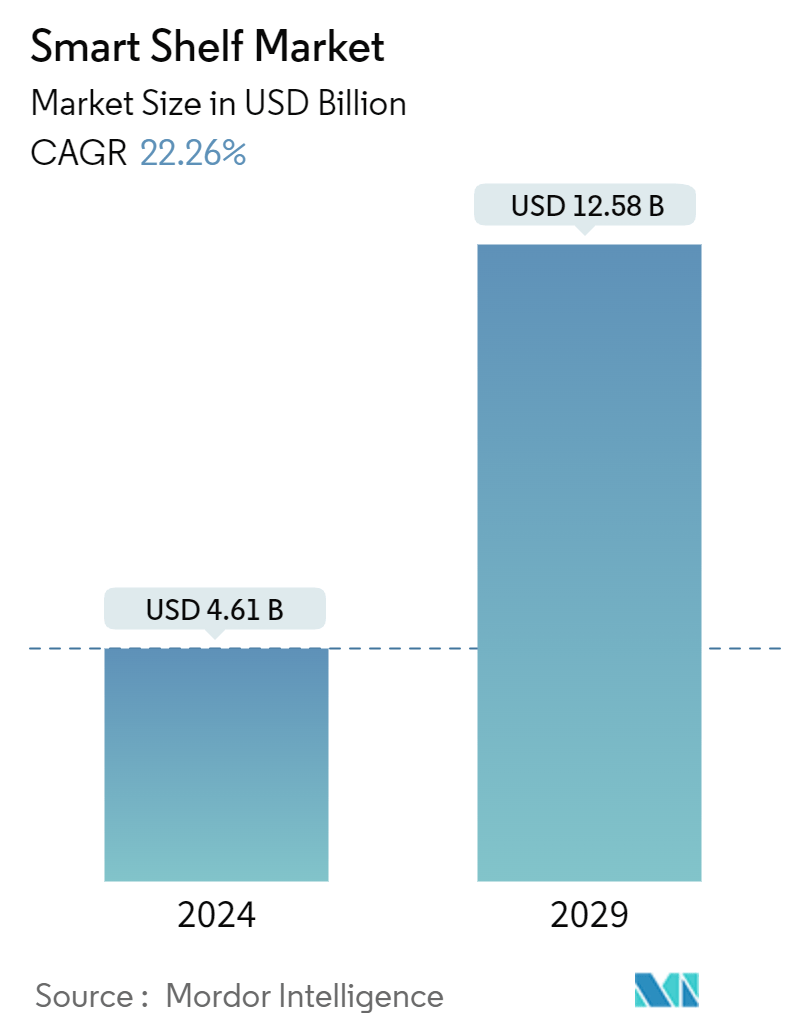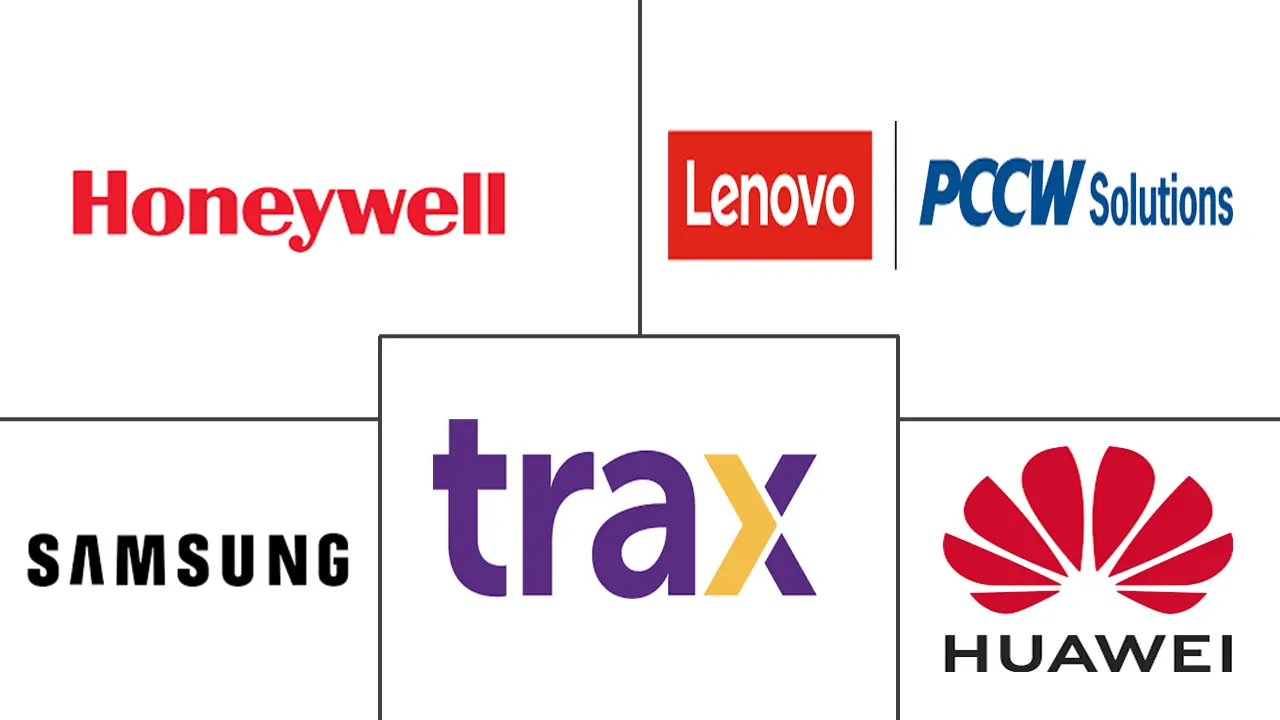Market Size of Smart Shelf Industry

| Study Period | 2019 - 2029 |
| Market Size (2024) | USD 4.61 Billion |
| Market Size (2029) | USD 12.58 Billion |
| CAGR (2024 - 2029) | 22.26 % |
| Fastest Growing Market | Asia-Pacific |
| Largest Market | Europe |
| Market Concentration | Low |
Major Players
*Disclaimer: Major Players sorted in no particular order |
Smart Shelf Market Analysis
The Smart Shelf Market size is estimated at USD 4.61 billion in 2024, and is expected to reach USD 12.58 billion by 2029, growing at a CAGR of 22.26% during the forecast period (2024-2029).
Smart shelves are electronically connected shelves used in retail outlets to track inventory. Smart shelves use a combination of digital displays, RFID tags, and sensors to provide detailed product information, cross-selling recommendations, and marketing. They also provide retailers with valuable insights into customer shopping patterns and preferences.
- The primary reasons driving the Smart Shelf Market are the commission of improved inventory management by retail to make smarter restocking options and real-time involvement, as well as the use of intelligence and automation technologies by retail to provide a better shopping experience for customers.
- Rising demand for natural and premium products promotes market development due to increased urbanization and consumer buying power. Retail automation is growing more popular, and there is a strong demand among retailers for pricing optimization and enhanced operating effectiveness with real-time product placement. These are only a few of the major factors fueling the market's global rise.
- E-commerce platform sales are rapidly increasing; this development provides a chance for the researched industry to flourish by giving new items to e-commerce warehouses to manage effective inventory management. According to the US Census Bureau, commercial e-commerce in the United States was about USD 266 billion from July to September 2022, a 3% increase over the past quarter. Furthermore, rising retail sales is also propelling the industry.
- RFID tracking does not stop when a customer leaves the store. If customers pay with a credit or debit card or scan a loyalty discount card at checkout, retailers may link the purchases to the RFID data and use the information to map out individual customers' travels around the store, or even an entire shopping complex. This indicates it is harming the user's privacy, which acts as an obstacle to the growth of the market.
- Post-COVID-19, the mart shelves market is expected to grow faster as retailers seek to leverage advanced technologies' benefits to improve inventory management and optimize their supply chain. With the rise of e-commerce and changing consumer behavior, retailers are looking for innovative ways to enhance the in-store experience and increase customer loyalty.
Smart Shelf Industry Segmentation
A Smart Shelf is used to display product pricing on store shelves, and it controls the central server and updates continuously. Smart shelves offer thorough product information, marketing advice, cross-selling ideas, and perceptions into the preferences and spending patterns of clients of organizations. They accomplish this by using RFID tags, digital displays, and sensors.
The Smart Shelf Market is segmented by component (hardware [IoT sensors, RFID tags and readers, electronic shelf labels, cameras], software, service), application (inventory management, pricing management, content management, planogram management), and by geography (North America [United States, Canada], Europe [United Kingdom, Germany, Italy, France, Rest of Europe], Asia Pacific [China, India, Japan, South Korea, Australia & New Zealand, Rest of Asia Pacific], Latin America [Brazil, Mexico, Rest of Latin America], Middle East and Africa). The report offers market forecasts and size in value (USD) for all the above segments.
| By Component | ||||||
| ||||||
| Software | ||||||
| Service |
| By Application | |
| Inventory Management | |
| Pricing Management | |
| Content Management | |
| Planogram Management | |
| Other Applications |
| By Geography*** | ||||||
| ||||||
| ||||||
| ||||||
| Australia and New Zealand | ||||||
| ||||||
| Middle East and Africa |
Smart Shelf Market Size Summary
The Smart Shelf Market is poised for significant growth, driven by the increasing adoption of advanced technologies in retail environments. Smart shelves, equipped with digital displays, RFID tags, and sensors, are transforming inventory management by providing real-time data and insights into customer behavior. This technology enables retailers to optimize restocking processes, enhance customer experiences, and improve operational efficiency. The rise of e-commerce and the demand for premium products further fuel the market's expansion, as retailers seek innovative solutions to manage inventory across multiple sales channels. Despite challenges related to privacy concerns, the post-COVID-19 landscape is expected to accelerate the adoption of smart shelves as retailers leverage these technologies to streamline supply chains and boost customer loyalty.
In Europe, the smart shelf market is experiencing robust growth, with countries like the United Kingdom, Germany, Italy, and France leading the charge. European retailers are early adopters of electronic shelf labels, which are integral to retail digitalization efforts. Collaborations and innovations, such as solar-powered labels and IoT platforms, are enhancing the region's market dynamics. Key players in the global market, including Avery Dennison Corporation and Huawei Technologies Co. Ltd, are actively introducing new products and forming strategic partnerships to maintain competitive advantages. The market's competitive nature is further underscored by recent developments, such as Samsung's AI-enabled home appliances and E Ink's sustainable electronic shelf label solutions, which highlight the ongoing technological advancements shaping the industry's future.
Smart Shelf Market Size - Table of Contents
-
1. MARKET INSIGHTS
-
1.1 Market Overview
-
1.2 Industry Attractiveness - Porter's Five Forces Analysis
-
1.2.1 Bargaining Power of Suppliers
-
1.2.2 Bargaining Power of Consumers
-
1.2.3 Threat of New Entrants
-
1.2.4 Threat of Substitute Products
-
1.2.5 Intensity of Competitive Rivalry
-
-
1.3 Industry Value Chain Analysis
-
1.4 Assessment of Impact of COVID-19 on the Market
-
-
2. MARKET SEGMENTATION
-
2.1 By Component
-
2.1.1 Hardware
-
2.1.1.1 IoT Sensors
-
2.1.1.2 RFID Tags and Readers
-
2.1.1.3 Electronic Shelf Lables (ESL)
-
2.1.1.4 Cameras
-
-
2.1.2 Software
-
2.1.3 Service
-
-
2.2 By Application
-
2.2.1 Inventory Management
-
2.2.2 Pricing Management
-
2.2.3 Content Management
-
2.2.4 Planogram Management
-
2.2.5 Other Applications
-
-
2.3 By Geography***
-
2.3.1 North America
-
2.3.1.1 United States
-
2.3.1.2 Canada
-
-
2.3.2 Europe
-
2.3.2.1 United Kingdom
-
2.3.2.2 Germany
-
2.3.2.3 Italy
-
2.3.2.4 France
-
-
2.3.3 Asia
-
2.3.3.1 China
-
2.3.3.2 India
-
2.3.3.3 Japan
-
2.3.3.4 South Korea
-
-
2.3.4 Australia and New Zealand
-
2.3.5 Latin America
-
2.3.5.1 Brazil
-
2.3.5.2 Mexico
-
-
2.3.6 Middle East and Africa
-
-
Smart Shelf Market Size FAQs
How big is the Smart Shelf Market?
The Smart Shelf Market size is expected to reach USD 4.61 billion in 2024 and grow at a CAGR of 22.26% to reach USD 12.58 billion by 2029.
What is the current Smart Shelf Market size?
In 2024, the Smart Shelf Market size is expected to reach USD 4.61 billion.

